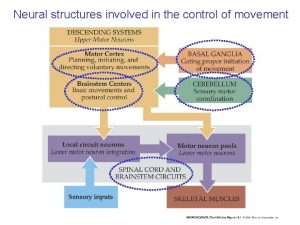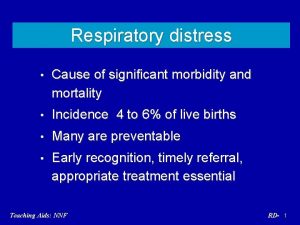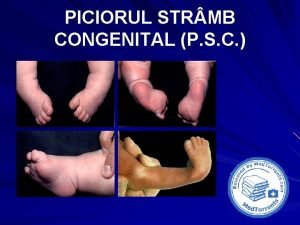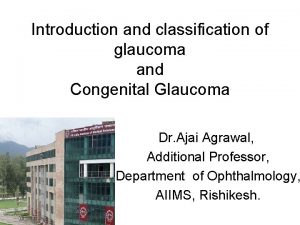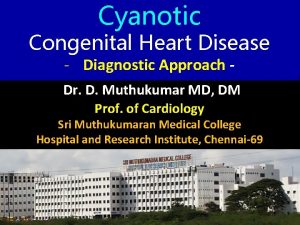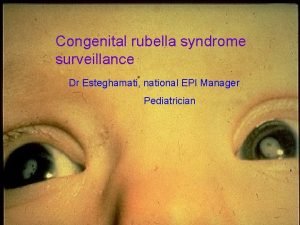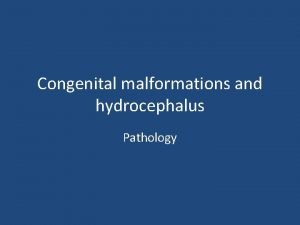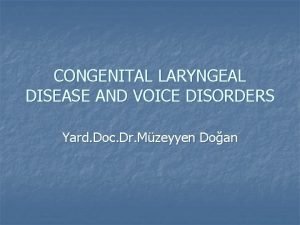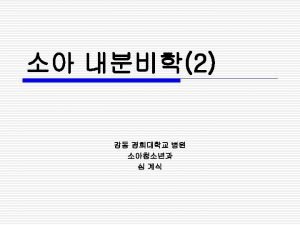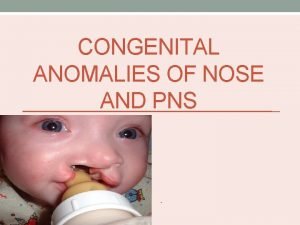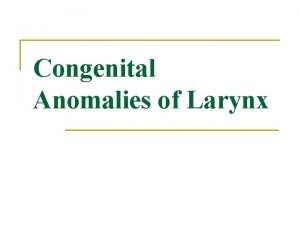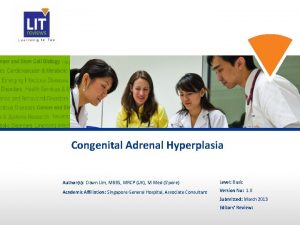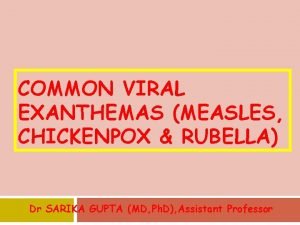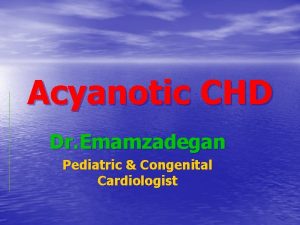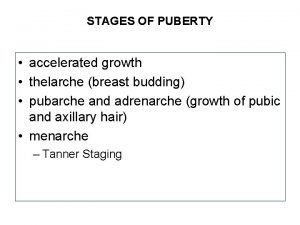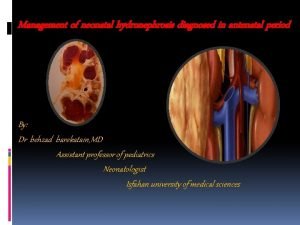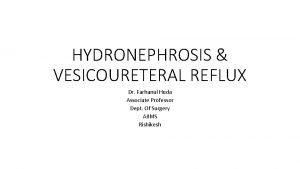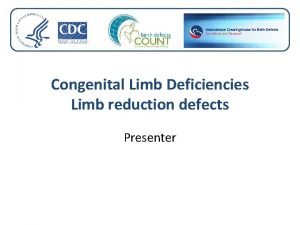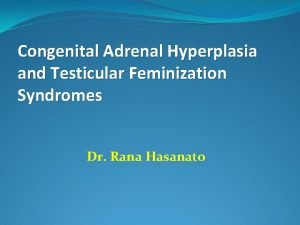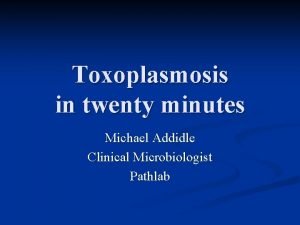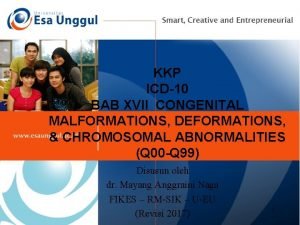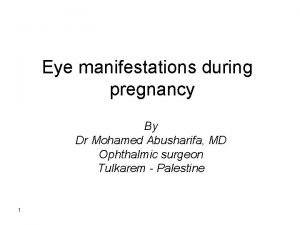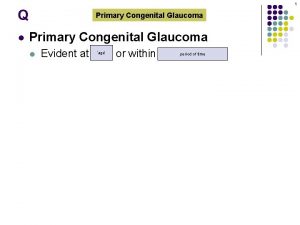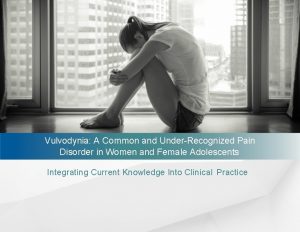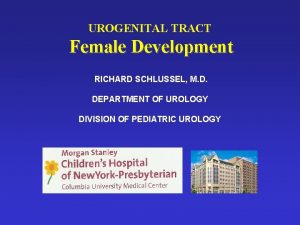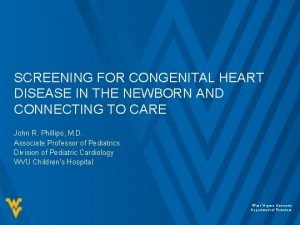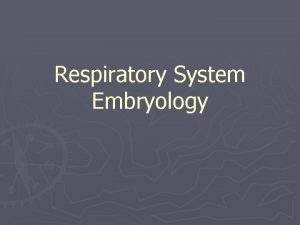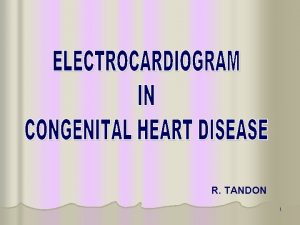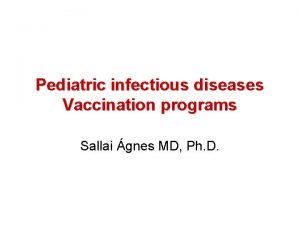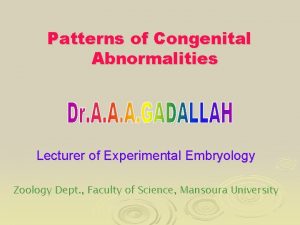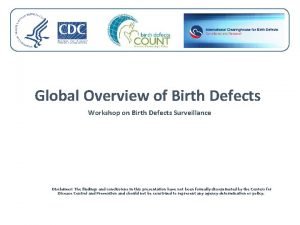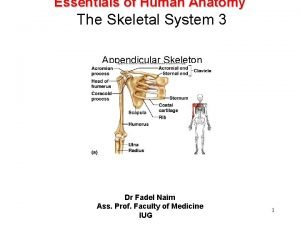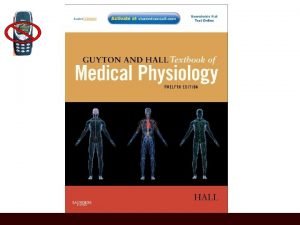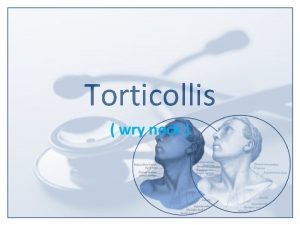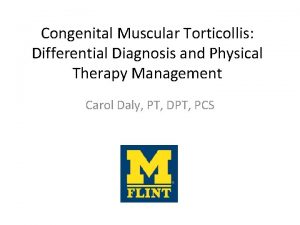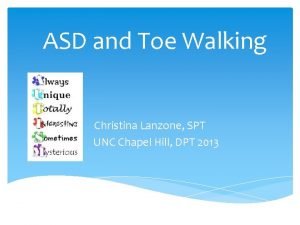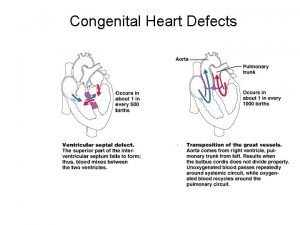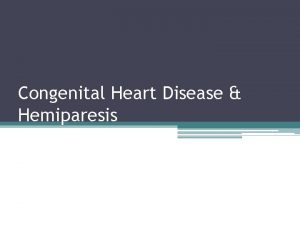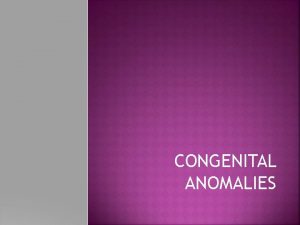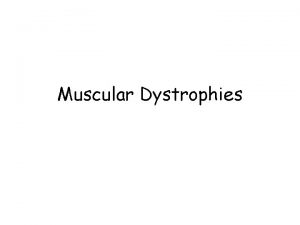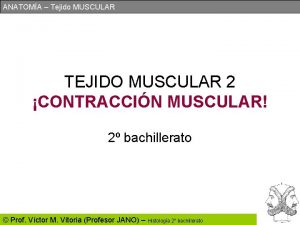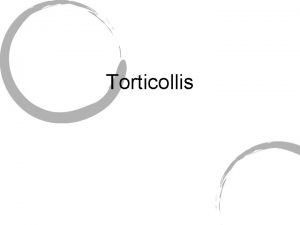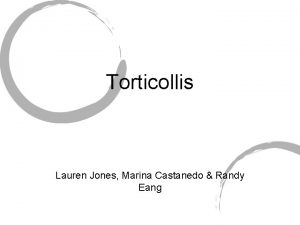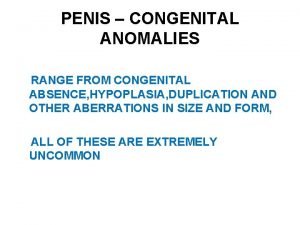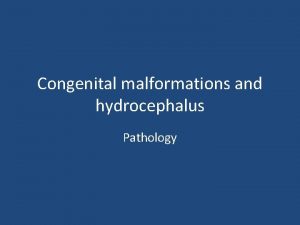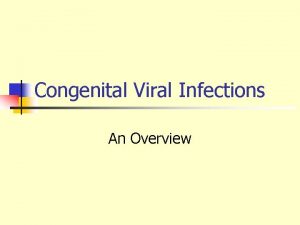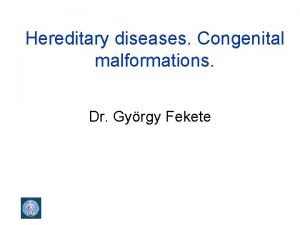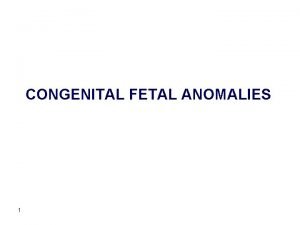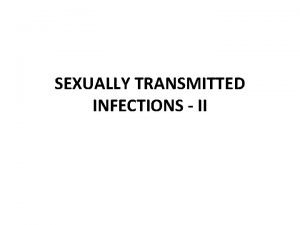Congenital Muscular Torticollis A Case Study Christina Lanzone










































- Slides: 42

Congenital Muscular Torticollis: A Case Study Christina Lanzone SPT 2013

Agenda �Torticollis classes and differential diagnosis �Exam elements and findings �Evaluation �Intervention �Functional Outcome Assessment/Outcomes �Other Interventions �EBP

Initial Presentation � 3 year old child with torticollis coming to see you and your CI doesn’t know anything about peds! �Have they always had torticollis? �Shouldn’t they have been treated as an infant?

Torticollis �twisted neck in which the head is tipped to one side, while the chin is turned to the other � 3 classes: �Congenital � Existing at or before birth �Acquired � Develops later in life �Spasmodic � symptoms occur irregularly

Congenital Torticollis �Inherited �Intrauterine malpositioning �Disruption in oxygen supply �Nuchal chord �Birthing trauma

Acquired Torticollis �Not a diagnosis but a sign of an underlying disorder �Causes include ligamentous, muscular, osseous, ocular, psychiatric, and neurologic disorders and may be a symptom of significant abnormalities of the spinal cord and brain � 1 in 5 children with torticollis have a nonmuscular etiology

Acquired Torticollis Secondary to: � Sandifer Syndrome � GERD? Dystonia? Symptoms assc. with eating? Epigastric discomfort? Abnormal eye movements? anemia? � Benign paroxysmal torticollis (BPT) � Tortipelvis? Ataxia? Migraines? Nystagmus? � Posterior fossa pathology � Brachial Plexus injury � Skeletal deformity � Ocular lesion � Vision checked?

Spasmodic Torticollis �neurological movement disorder �Called Cervical Dystonia �Predominately idiopathic �Can be secondary symptom �Typically presents later in life

Differential Diagnosis Exam Elements �GERD �Spasmodic �Dystonic �Symptoms assc. with ingestion of food �Epigastric pain �Hematemesis �Nystagmus �Anemia �Tortipelvis �Ataxia �Migraines �Vision problems

Examination: Subjective �Age of Diagnosis �Prenatal, Labor and Birth History �Developmental history �Past medical history �Torticollis Presentation �Differential Diagnosis questions �Habitual positioning and feeding �Family/patient goals

Prenatal, Labor, and Birth History �born at 36 weeks gestation and was 7. 6 lbs and 10 inches long �Mother’s first pregnancy and delivery �Vaginal delivery �Mother had Ulcerative Colitis �Multiple flare-ups throughout pregnancy � Multiple occasions of excessive blood loss �Had many ultrasounds �At a routine checkup, discovered amniotic fluid was dangerously low and induced labor

Prenatal, Labor, and Birth History… �Long and difficult labor �Nuchal chord but not in breach position �Physician had to pull him out, did not use forceps and did not have brachial plexus injury �Was not breathing upon delivery �Mother stated that he had “died two times” but was “fine after that”

Prenatal, Labor, and Birth History… �Patient also had jaundice at birth �Had extended stay at hospital until this resolved

Developmental History: �Insignificant other than torticollis �No plagiocephaly or hip dysplasia �Early treatment for torticollis �Reported that they had some therapy and that it helped a little but they stopped going and doing the stretches �Just had his checkup with his pediatrician �Mother stated that he had no developmental delays and was at a “ 5 year old level”

Past medical History: �Birthing trauma �Jaundice at birth �Recurrent ear infections �Tubes and adenoids removed 5 months ago

Torticollis Presentation: �Stated that he tilts his head to the left and does it more when he is tired or drinking from his sippy cup

Differential Diagnosis Questions: �GERD �Spasmodic �Dystonic �Symptoms assc. with ingestion of food �Epigastric pain �Hematemesis �Nystagmus �Anemia �Tortipelvis �Ataxia �Migraines �Vision problems �Answered no to all questions

Habitual Positioning and Feeding �Sleeps on either side �Does not W sit �Plays standing or sitting �Mother notes that when he runs he turns his L foot out �Eats “normal food” �Takes vitamins �Ambidextrous, but physician thinks he will be lefthanded

Family Goals �Mother stated that she wanted to have him checked so that he would not have any associated problems later in life

Examination: Objective �Communication �Postural observation �ROM �Palpation �Strength �Gross Motor Skills �Transfer Skills �Motor Planning Abilities

Communication �Advanced for his age �first patient to call me a doctor �Said that we were “nice doctors” because we did not give him a shot

Postural Observation �Often displays slight L cervical side-bending and rotation �Slightly unusual: torticollis typically caused by damage to SCM which causes side-bending towards and rotating away �L upper trapezius and cervical extensors more active with movement and more pronounced �No other sided differences in appearance

ROM �Assessed by playing “Simon Says” �All cervical ROM WNL except only had 80% of R cervical rotation �Shoulder, elbow WNL

Palpation �Palpated cervical musculature �Did not find any scar tissue in SCM �No tenderness to palpation �Normal paraspinal tone

Strength and Gross Motor Skills �Normal shrug �Assessed strength mostly through observation of play in PT gym �Could hang from balance bars �Could jump on Rebounder �Could throw ball with both hands or each hand separately �No sided-differences in strength including UEs

Strength and Gross Motor Skills… �Normal gait �Running: ER of LLE �Can jump �Can only catch ball with both hands �Uses both arms together for play and manipulation of objects �Noted preference of use of L UE for play

Transfer Skills and Motor Planning �Uses both arms to climb up onto and scoot off of plinth �No noted motor planning difficulty

Evaluation Assessment: Pt is a 35 month old male who presents with cervical postural abnormality: slight L SB and L rot and decreased R cervical ROM. These limitations cause patient to favor cervical motion to the L partially neglecting motion to the R. These limitations and history of birthing trauma are consistent with doctor’s diagnosis of torticollis. Pt’s prognosis is good: patient is moderately limited in R cervical ROM and with education the family can position to minimize postural abnormality and decrease risk of developmental delays or abnormalities.

Evaluation: PT Diagnosis �Congenital Muscular Torticollis (CMT) �PT Diagnosis Code: 723. 5 Torticollis (unspecified)

Evaluation: APTA Practice Pattern �Pattern 4 B: Impaired Posture �Pattern 4 C: Impaired Muscle Performance �Pattern 4 D: Impaired Joint Mobility, Motor Function, Muscle Performance, and Range of Motion Associated with Connective Tissue Dysfunction

Evaluation: Goals 1) Family will verbalize proper positioning for sleep and activity so that patient can gain more normal cervical posture and ROM. 2) Family will demonstrate understanding of condition to 90% PT satisfaction so that they can better manage their son’s treatment.

Evaluation: Prognosis �Pt’s prognosis is good: patient is moderately limited in R cervical ROM and with education the family can position to minimize postural abnormality and decrease risk of developmental delays or abnormalities

Initial Treatment Given: �Family educated about how to position him for play and sleep �Have him sleep on his R side �Position toys/food to his R side �Hold him on your left side �Position yourself to his R side

Intervention �Plan: patient would be treated 1 x/wk for 2 wks �Treatment to include: �Family education: positioning for sleeping, play, and eating and general information about condition �Strengthening his R cervical musculature: find games in which he has to turn his head to the right

Function Outcome Assessment Tools �We measured cervical rotation and side-bending and noted his neutral head position �These measures are used in studies to measure effects of intervention �Specific to torticollis

Function Outcome Assessment Tools… �No disease-specific functional outcome assessment for torticollis �Could have used other more general measures to address issues across the ICF continuum �Impairment: cervical ROM and neutral head position �Activity: Denver II �Participation: Children’s Assessment of Participation and Enjoyment (CAPE) �Health related QOL: Child Health Questionnaire (CHQ)

Outcomes �Patient did not return for follow-up appointments

Other Possible Interventions � Conservative treatment � positioning � AROM � passive stretching � Strengthening � Orthoses � TOT collar (tubular orthosis for torticollis) � Botulin injections (more often for spastic forms) � Surgery � Unipolar release � Bipolar release � Endoscopic release � Subperiosteal lengthening

Evidence Based Practice �Passive stretching is most effective for children under 1 year of age �Earlier treatment results in better outcomes and shorter period of therapy �For children and adults, surgical intervention is the most effective treatment �Surgical intervention is best when the patient is over 10 years old

Questions?

Sources �APTA. (2003). Interactive guide to physical therapist practice. Retrieved from http: //guidetoptpractice. apta. org/content/current �Cheng, J. (1999). Outcome of surgical treatment of congenital muscular torticollis. Department of Orthopaedics and Traumatology, Retrieved from http: //www. ncbi. nlm. nih. gov/pubmed �Freed, S. , & Coulter-O'Berry, C. (2004). Identification and treatment of congenital muscular torticollis in infants. American Academy of Orthotists and Prosthetists, 16(4 S), 18 -23. Retrieved from http: //www. oandp. org/jpo/library/2004_04 s_018. asp

Sources… � Mymensingh, M. J. (2010). Congenital muscular torticollis: experience of 14 cases. Department of Pediatric Surgery, Retrieved from http: //www. ncbi. nlm. nih. gov/pubmed/20956899 � Othee, G. S. (2010). Torticollis surgery. Medscape reference, Retrieved from http: //emedicine. medscape. com/article/1243022 � Pediatric Orthopaedic Society of North America. (2007). Congenital torticollis. American Academy of Orthopaedic Sugreons, Retrieved from http: //orthoinfo. aaos. org/topic. cfm? topic=a 00054 � Sonmez, K. (2005). Congenital muscular torticollis in children. Department of Pediatric Surgery , Retrieved from http: //www. ncbi. nlm. nih. gov/pubmed/16327275 � Torticollis. In (2010). L. Vorcick (Ed. ), Pub. Med Health A. D. A. M Medical Encyclopedia Retrieved from http: //www. ncbi. nlm. nih. gov/pubmedhealth/PMH 0001757/
 Torticollis
Torticollis Differentiate muscular strength from muscular endurance
Differentiate muscular strength from muscular endurance Best worst and average case
Best worst and average case Fbi virtual case file case study
Fbi virtual case file case study Congenital pneumonia
Congenital pneumonia Congenital pneumonia
Congenital pneumonia Piciorul stramb congenital
Piciorul stramb congenital Trabeculodysgenesis meaning
Trabeculodysgenesis meaning Eisenmenger syndrome
Eisenmenger syndrome Congenital rubella syndrome
Congenital rubella syndrome Congenital malformations
Congenital malformations Congenital voice disorders
Congenital voice disorders Hypothyroidism classification
Hypothyroidism classification Asd vs pulmonary stenosis murmur
Asd vs pulmonary stenosis murmur Tga cxr
Tga cxr Congenital fibrosis of the extraocular muscles
Congenital fibrosis of the extraocular muscles Polyrhinia
Polyrhinia Larynx
Larynx Congenital adrenal hyperplasia electrolytes
Congenital adrenal hyperplasia electrolytes Congenital rubella syndrome triad
Congenital rubella syndrome triad Complete endocardial cushion defect
Complete endocardial cushion defect Congenital rubella syndrome triad
Congenital rubella syndrome triad Congenital adrenal hyperplasia characteristics
Congenital adrenal hyperplasia characteristics Potter face oligohydramnios
Potter face oligohydramnios Congenital hydronephrosis
Congenital hydronephrosis Defect
Defect Site:slidetodoc.com
Site:slidetodoc.com Congenital toxoplasmosis
Congenital toxoplasmosis Kode icd 10 clubfoot
Kode icd 10 clubfoot Congenital toxoplasmosis
Congenital toxoplasmosis Choledocolithaisis
Choledocolithaisis Canadian congenital heart alliance
Canadian congenital heart alliance Glaucoma
Glaucoma Vulvodynia
Vulvodynia Schlussel urology
Schlussel urology Congenital heart disease pda
Congenital heart disease pda Congenital diaphragmatic hernia
Congenital diaphragmatic hernia Congenital heart
Congenital heart Congenital rubella
Congenital rubella Micrognathia definition
Micrognathia definition Causes of congenital anomalies
Causes of congenital anomalies Surgical neck
Surgical neck Congenital adrenal hyperplasia
Congenital adrenal hyperplasia
